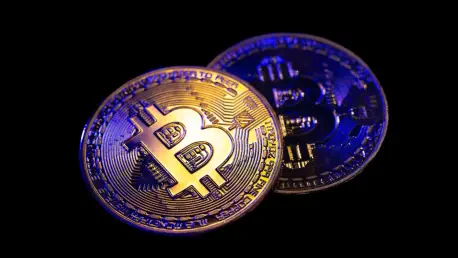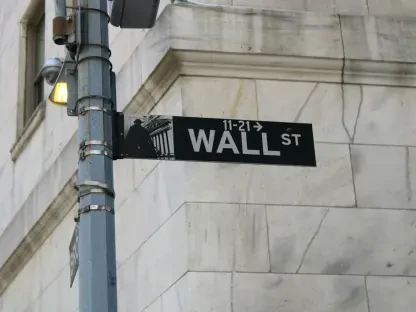Amidst the ever-evolving financial landscape, Bitcoin’s temporary decoupling from traditional market trends in April garnered significant attention from investors and analysts alike. Originating from turbulent geopolitical and economic circumstances, this shift posed intriguing questions about Bitcoin’s potential to act as a stabilizing force amid chaos. Bitcoin emerged as a macroeconomic hedge against standard market volatilities, albeit for a brief period, raising hopes of transforming into a self-reliant financial asset. While initial optimism was promising, developments throughout April revealed complex interactions between Bitcoin and traditional risk markets, ultimately impacting its perceived role as an independent entity in an unpredictable economic climate.
Geopolitical Catalysts and Market Reactions
The unexpected announcement of comprehensive tariff measures by U.S. President Donald Trump was a defining geopolitical event, triggering significant market ramifications globally. Traditional assets like the S&P 500 and gold were profoundly impacted, with a widespread sell-off reflecting investor apprehension. In contrast, Bitcoin’s value ascended, diverging from the trajectory of these conventional financial markets. As other assets struggled to maintain value amid fears of economic instability, Bitcoin’s rise from $81,500 to over $84,500 highlighted a shift in investor sentiment, possibly recognizing it as a hedge against volatility. This reaction demonstrated a complex interplay between the cryptocurrency and the broader financial landscape, casting Bitcoin in a promising light due to its ability to defy typical correlations, albeit temporarily.
Investor sentiment during this period seemed to portray Bitcoin as a viable store of value, contrasting starkly against traditional financial assets. While the initial response signaled a decoupling, allowing Bitcoin to temporarily outshine conventional markets, this perception was not enduring. As April progressed, Bitcoin’s trajectory reverted, aligning more closely with the movements of traditional equities. This rapid return to correlation indicated the ongoing influence of standard market dynamics on Bitcoin’s value in unexpected geopolitical contexts. These fluctuating correlations underlined the potential and limitations of Bitcoin’s ability to break free from established market trends, affirming the cryptocurrency’s place within the broader financial ecosystem.
Bitcoin’s Correlation Dynamics
Following the geopolitical turmoil, Bitcoin’s correlation with the S&P 500 showcased a fascinating fluctuation, initially decreasing to under 0.25. This marked a significant departure from traditional market behaviors, hinting at potential freedom from the influence of equity trends. However, as April neared completion, this correlation rebounded to 0.55, underscoring Bitcoin’s short-lived detachment from typical risk markets. VanEck’s analysis highlighted the nuanced and transient nature of Bitcoin’s decoupling, suggesting its continued reliance on traditional risk market dynamics despite its brief period of divergence. These dynamics demonstrated Bitcoin’s fluctuating role in the economic landscape, reflecting ongoing challenges in disentangling from conventional financial systems.
In assessing these correlation dynamics, the cryptocurrency’s fleeting detachment illustrated both the promise and constraints of Bitcoin’s macroeconomic influence. The temporary decrease in correlation reflected a period of potential autonomy, characterizing Bitcoin’s potential as a stabilizing asset in turbulent times. Nevertheless, the subsequent rebound and realignment with equities highlighted Bitcoin’s reliance on traditional market forces, underscoring its vulnerability to prevailing financial conditions and investor sentiment. Bitcoin’s evolving correlation dynamics emphasize the complexities involved in striving for independence, offering intriguing insights into its future potential within continuously shifting economic environments.
Resilience Amidst Volatility
Bitcoin demonstrated remarkable resilience in April, with its value increasing by 13% amid geopolitical tensions, while traditional indices like NASDAQ and S&P 500 experienced losses or stagnation. The diminished volatility in Bitcoin compared to the equity market’s increased fluctuations reflected an emerging perception of Bitcoin as a store-of-value asset. Such resilience amidst global economic pressures indicated Bitcoin’s growing consideration as a portfolio stabilizer, enabling investors to rethink their strategies in light of evolving financial conditions. Bitcoin’s capacity to withstand economic disruptions signaled a shift in how it may be perceived by markets grappling with uncertainty, solidifying the argument for its expanded role in portfolios.
The disparity between Bitcoin’s growth and the faltering traditional indices highlights the potential for cryptocurrencies to act as alternative assets during times of financial instability. As the traditional markets demonstrated increasing vulnerability, Bitcoin’s performance offered hope for those seeking refuge in less conventional financial options. The decrease in Bitcoin’s volatility during this tumultuous period further reinforced its ability to emerge as a reliable asset, challenging entrenched beliefs about its stability and market behavior. Such demonstrations of resilience add a layer of consideration to Bitcoin’s financial narrative, inviting ongoing discussions about its long-term positioning within uncertain market environments.
Emergence of Sovereign and Corporate Support
As geopolitical tensions unfolded in April, Bitcoin witnessed increased recognition and interest from sovereign and corporate sectors, further bolstering its position as a macroeconomic hedge. Countries like Venezuela and Russia began to adopt Bitcoin for international trade purposes, signifying a pivotal structural shift. This heightened sovereign interest complemented the parallel surge in corporate acquisitions, reflecting strategic reallocations toward Bitcoin as potential stabilizing assets. Notable acquisitions by Strategy, Metaplanet, and a consortium involving Softbank reinforced Bitcoin’s evolving role, signifying confidence in its potential amidst traditional finance vulnerabilities. These developments illustrated Bitcoin’s emergence as a viable option for entities seeking alternative financial strategies.
Sovereign and corporate interest marked a notable phase in Bitcoin’s trajectory, emphasizing its increasing credibility and perceived value in diverse financial sectors. As these entities explored Bitcoin’s functionality beyond speculative investment, the evolution of Bitcoin’s role as a portfolio stabilizer came into sharper focus. The strategic acquisitions underscored a critical recognition, suggesting Bitcoin’s growing legitimacy within broader economic frameworks. This recognition invites further exploration into the asset’s potential, aligning with the idea that Bitcoin’s role as a hedge against traditional finance will continue to expand in response to market fragilities, inviting broader acceptance and incorporation into global financial strategies.
The Divergent Fate of Altcoins
In the ever-changing financial world, Bitcoin’s brief divergence from traditional market trends in April caught the eye of investors and analysts, sparking debates about its potential as a stabilizing force during chaotic times. This shift emerged from a backdrop of turbulent geopolitical and economic conditions, prompting curiosity about Bitcoin’s ability to function as a macroeconomic hedge against common market fluctuations. For a short span, Bitcoin offered a glimpse into transforming as a self-sufficient financial asset, inciting optimism among stakeholders. However, throughout April, evolving dynamics revealed intricate ties between Bitcoin and conventional risk markets. These connections challenged initial perceptions of Bitcoin’s ability to stand independently as an asset in an unpredictable economic landscape. These developments invite further examination into Bitcoin’s true potential, as the cryptocurrency endeavors to define its role amidst global economic uncertainties and market volatilities.









